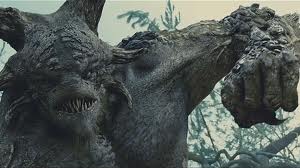 |
| Visually compelling but short on lots of story elements. |
My YA daughter, a stalwart Kristen Stewart fan (thanks to Twilight) countered my every criticism with, “Oh, it’s not that bad.” Then I realised how much was just not that good, and how a movie’s failings (visual book thing again) can translate to the page for authors. So, what can we learn from Snow White and the Huntsman?
I read a few reviews to help me understand why I did not enjoy this visual feast, for a visual feast it is. From the red blood, to the white snow, to the raven black elements, to the knights in silvery shining armour racing along the beach with swords drawn, all the beauty is there … but it cannot sustain what is essentially a great story told poorly.
 |
| Great action sequences! |
 |
| Real scene stealers! |
The Huntsman locates Snow White in the Dark Forest but Finn admits that Ravenna cannot resurrect the dead. The Huntsman then helps Snow White to escape, promising to escort her to Duke Hammond's castle in exchange for a reward of gold. They meet the dwarves who just about steal the show, and thereafter it’s on to the Duke’s castle to round up an army to defeat the evil Queen.
 |
| Wonderful fairy tale troll! |
So how can we look at this film and learn some writing lessons?
Let’s check out the reviews. These comments (I've underlined the most telling) can be applied to writing.
Rotten Tomatoes: While it offers an appropriately dark take on the fairy tale that inspired it, Snow White and the Huntsman is undone by uneven acting, problematic pacing, and a confused script.
The Washington Post: Michael O’Sullivan says: Too many bad apples spoil a tale. Overlong, overcrowded, overstimulating and with an over-the-top performance by Charlize Theron as the evil queen Ravenna, the movie is a virtual orchard of toxic excess, starting with the unnecessarily sprawling cast of characters. Snow White and the Huntsman feels less like a movie than a deadly cocktail of movie clichés, all of which have been thrown into a blender, set to ‘slow’ and pureed for two hours.
The San Francisco Chronicle: “…which takes everything mythic about ‘Snow White’ and pounds it out until it's flat and dead. It takes something whose truth is elusive and turns it into a movie that's obvious and trivial. The fairy tale … suffers from a problem in its rhythm. It's not that its pace is too slow, but that it's too regular, and this lack of syncopation makes it feel slow.
Ouch!
A Writer’s Digest article advises: Analyze successful stories. They (writers) ask questions when reading and use their findings to help strengthen their work. For example:
• How does the writer make me want to turn the page?
• Why am I drawn to the lead character?
• When are the stakes raised?
• How does the writer integrate minor characters?
• What makes a scene work?
• What’s the key to conflict?
• How does the writer handle dialogue?
In my humble opinion, the problem with Snow White is that loads of bad stuff eclipsed loads of good stuff. A cleaner, simpler story, tighter pacing, consistent characterization, believable motivation, a good sub-text and backstory, and quicker links to the actually great action scenes would have transformed this film into a iconic version of a tried and tested tale of good triumphing over evil. People don’t get tired of a good story told well.
How well are you telling your story?
No comments:
Post a Comment